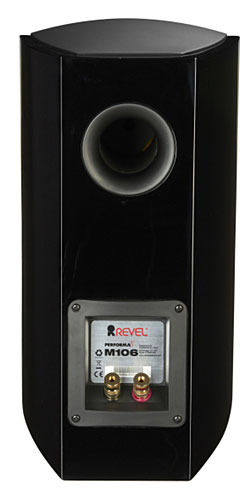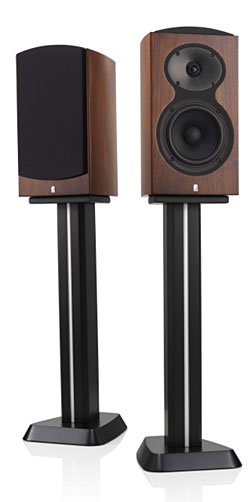| Columns Retired Columns & Blogs |
Revel Performa3 M106 loudspeaker Page 2
I'm anxious to see John Atkinson's measurements of the M106's bass extension. In terms of clarity, neutrality, and forcefulness, I found the speaker's bottom end impressive for a bookshelf model of its size: just 14.9" high by 8.2" wide by 10.8" deep, and weighing just 17.6 lbs. In Eberhard Weber's Endless Days (CD, ECM 1748), Rainer Brüninghaus's bass-synthesizer lines filled and enveloped my listening room. From my notes: "Bloooooooom!"
Footnote 4: This is one of several tracks I've used to prepare the "Comparisons" section of every review I've written for Stereophile. If you multiply the number of my reviews published in the magazine by four or five times, you get the number of times I've played this song in my listening room. It's gotten to the point that, whenever I start to play "Walking on Sacred Ground," my wife and kids know that they're going to hear it several more times over the next few hours. Typically, they leave the house.
The Performa3 M106 exhibited two strengths that deserve more detailed discussion. In these areas, the speaker exceeded the performance of any other bookshelf speaker I've heard, regardless of price:
Upper-bass clarity, transparency, and detail: In the 90–120Hz region, there was a purity in the sounds of all instruments that made every other speaker I've heard sound comparatively muddy, smeared, or indistinct. In Paul Bley's Fragments (CD, ECM 1320), the lower register of John Surman's bass clarinet sounded woody, chesty, rich, and involving, with that instrument's unique timbre shining through. In "Donatella," from ArtPop, Lady Gaga uses an interesting synth patch to create the bass line: a pure waveform morphed with a buzzy artifact. The sound is unique, and the Revel made it easy to analyze how the sound was created. In Jim Hall & Basses (CD, Telarc CD-83506), the guitarist plays in a number of duo and trio formats alternating with five master double bassists: Scott Colley, Charlie Haden, Dave Holland, Christian McBride, and George Mraz. Through the M106 it was very easy to distinguish the unique sonic signature of each bass, as well each bassist's characteristic phrasing.
 Finally, one track that really floored me was "Walking on Sacred Ground," from Janis Ian's Breaking Silence (CD, Morgan Creek/Analogue Productions CAPP 027), which I've played in my listening more than a hundred times (footnote 4). This time, I focused on the technique of bassist Chad Watson. An electric bass guitar has four strings, each with a different thickness and tension. Typically, when a rock bassist plays, each string will be plucked at a different angle, assuming the right hand is stationary. For example, a G played on the D string will sound different from a G played on the A string and farther up the neck. The Revel seemed to magnify these differences—for the first time, I was keenly aware of when Watson was moved from string to string to play the same note. I could have mapped out his entire pattern of fingerings for "Walking on Sacred Ground."
Finally, one track that really floored me was "Walking on Sacred Ground," from Janis Ian's Breaking Silence (CD, Morgan Creek/Analogue Productions CAPP 027), which I've played in my listening more than a hundred times (footnote 4). This time, I focused on the technique of bassist Chad Watson. An electric bass guitar has four strings, each with a different thickness and tension. Typically, when a rock bassist plays, each string will be plucked at a different angle, assuming the right hand is stationary. For example, a G played on the D string will sound different from a G played on the A string and farther up the neck. The Revel seemed to magnify these differences—for the first time, I was keenly aware of when Watson was moved from string to string to play the same note. I could have mapped out his entire pattern of fingerings for "Walking on Sacred Ground."
Unsurpassed clarity of transient articulation: Listening to several more tracks from Breaking Silence, I studied drummer Jim Brock's technique. The percussion transients were lightning-fast and clean, but also relaxed and natural, with a "rightness" that made transients through other speakers sound mechanical or artificial. Many speakers blur the 32nd-note triplets that permeate Philip Glass's Einstein on the Beach, with Michael Riesman leading the Philip Glass Ensemble (CD, Elektra/Nonesuch 79323-2), but through the Revel they were coherent, detailed, crisp, clean, yet mellow. The transients of John Renbourn's guitar in his Sir John Alot of Merrie Englandes Musyk Thyng & ye Grene Knyghte (CD, Shanachie 97021) were pristine, with extended and airy highs. I believe that the M106 set a new standard for realism in the reproduction of picked flattop acoustic guitars.
In all of Susie Ibarra's percussion solos on her Radiance (CD, Hopscotch HOP 2), the Performa3 M106 let me analyze the technique of this master—who, in my view, is the only jazz drummer who approaches improvisation with the style of a classical orchestral percussionist. In Wayne Shorter's "Sakeena's Vision," from Art Blakey and the Jazz Messengers' The Big Beat (CD, Blue Note CDP 7 46400), Blakey takes a solo in which he many times repeats a simple riff on his smallest tom-tom. I had to drop what I was doing and stare at the speakers as I heard each skin attack perfectly, with a bed of air between each pair of thwacks. The last time I'd felt Blakey's presence as being so palpably in the room with me was back in the 1970s, when I stood on line behind him at the cash register at E.U. Wurlitzer Music and Sound, in Boston. (He was buying drumsticks; I was getting the action of my Fender Rhodes piano regulated.) Finally, the Revel M106's ability to articulate transients made its renderings of vocal sibilants more distinct, but without adding any harshness or spittiness to singers' phrasing.
The single recording that most nicely integrated all of the Performa3 M106's strengths was Maria Schneider's Coming About (CD, Enja ENJ-9069 2). This early recording is quite different from her more recent work in being more frantic and aggressive, with electric instruments used freely, and it had boisterous bloom through the Revel while still sounding delicate. The screech trumpet lines were as in-my-face as if from a Buddy Rich chart, and the tightly interlocking electric-bass lines from Tony Scherr (who I'm used to hearing play double bass with Bill Frisell) provided a solid, churning backdrop to Ben Monder's effects-laden electric guitar.
 Comparisons
Comparisons
I compared the Revel Performa3 M106 ($2000/pair, plus $500 for stands) to the Epos Elan 10 ($1000/pair without stands) and the Dynaudio Excite X12 ($1200/pair without stands). It wasn't an entirely fair comparison—both of the latter speakers are significantly less expensive than the Revel. That said, of all the bookshelf speakers I've reviewed, the Epos and the Dynaudio have been my favorites since I first heard them. If I want to throw together a system to listen to music on the spur of the moment, I choose one of them. But in every parameter of sound, the Performa3 M106 outperformed both of these wonderful speakers.
The Dynaudio Excite X12 was silky, warm, and natural, but in comparison to the Revel had less inner detail, a less articulate and warmer midbass, and less defined upper bass. Its highs were as clean and delicate as the M106's but had less definition, and sibilants were less pronounced. High-level dynamics were not as good as the Revel's, and transients were not as clean.
The Epos Elan 10 had a cleaner midbass than the Dynaudio, but its upper-bass clarity was not in the Revel's league. The Elan's high-level dynamics were better than the Dynaudio's, but the Revel's were better still. The Epos's highs weren't as delicate as the Revel's or Dynaudio's, and the M106's transient articulation was superior. The Elan 10's resolution of detail was better than the Excite X12's and was close to the M106's, but the Revel still resolved the most inner detail.
Summing Up
Revel's Performa3 M106 is an extraordinary bookshelf loudspeaker. Its strengths impressed me across the board, especially for a speaker of its size and price. And the M106's appearance is elegant and sexy—it exudes quality without taking up much space. I've reviewed several dozen bookshelf speakers since that Mirage in 1985, and I don't think I've enjoyed music of all genres through any of them as much as have through the M106. Kevin Voecks is a genius. No ifs, ands, or buts.
Footnote 4: This is one of several tracks I've used to prepare the "Comparisons" section of every review I've written for Stereophile. If you multiply the number of my reviews published in the magazine by four or five times, you get the number of times I've played this song in my listening room. It's gotten to the point that, whenever I start to play "Walking on Sacred Ground," my wife and kids know that they're going to hear it several more times over the next few hours. Typically, they leave the house.
- Log in or register to post comments




































